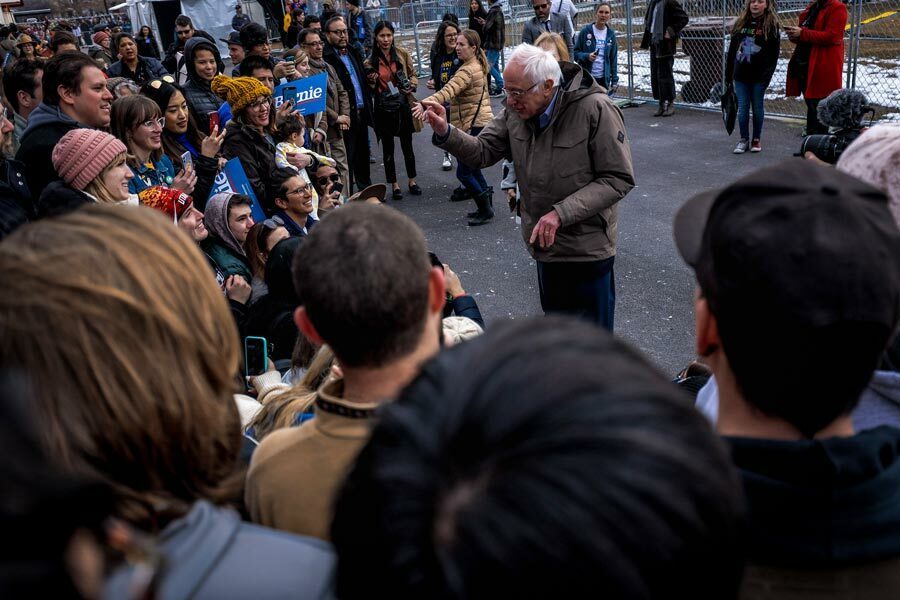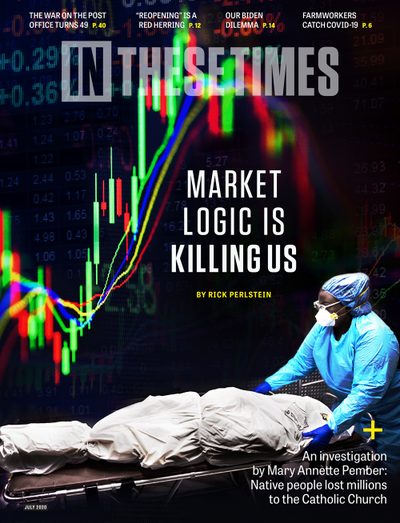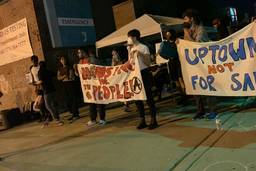The Church of Latter-Day Socialists
These Mormons are taking the church back to its socialist roots.
Nicholas Greyson Ward

SALT LAKE CITY — As about 60 people gather in a small suburban library in late February, a guest speaker proudly declares, “Bernie is the most Christ-like candidate I have ever seen.”
Though perhaps a small event, it stands out for another reason: The Bernie Sanders presidential campaign had largely avoided conversations about religious faith. This event specifically addressed the concerns of Utah’s largest voting bloc — members of the Church of Jesus Christ of Latter-day Saints.
Other speakers quoted Bible passages. One charismatic, middle-aged woman introduced herself as a Church member, then asked the crowd to encourage other members to vote for Sanders by talking about the issues they care most about, listening astutely and avoiding the topic of abortion.
Hailey Freeman, a 22-year-old college student who volunteered with the Sanders campaign in Salt Lake City, helped plan the event. Freeman is a Mormon and a member of the Salt Lake chapter of the Democratic Socialists of America (DSA). She tells In These Times that, out of roughly 200 active dues-paying DSA members, at least a dozen are Mormon or ex-Mormon — surprising, perhaps, because of the association between the Church and conservatism. In Utah, 62% of the state is Mormon; a Pew Research Center poll from 2016 shows 70% of Mormons identify as Republican.
But some Mormons, like Freeman, are rejecting that conservatism for socialism. “My home was very much a Fox News household,” Freeman says. “I’m pretty sure we have a George W. Bush reelection commemorative coin somewhere, if that gives you any idea of my family’s political leanings.” But in 2016, while Freeman was attending Brigham Young University, Bernie Sanders’ first presidential run opened the door for her to leftist thought. The campaign event she helped plan signaled, Freeman says, that a person can go to church and still be leftist.
The Mormon church does have some history of incubating socialist ideals. In the mid 1800s, the Church started the United Order, a social program that distributed property and goods among members. It faded by the early 20th century, but socialist thought persisted in Utah for decades after. In the early 1900s, an estimated 40% of the Socialist Party’s Utah membership was Mormon. Mormons, however, still faced persecution, and Church leadership discouraged socialist beliefs — fearing the ideas could prevent members from assimilating into mainstream America, a goal of the Church. By the Cold War, leadership adamantly denied the United Order was a form of socialism.
Political pluralism remained common among Mormons until Ezra Taft Benson, a militant anti-communist, became president of the Church in 1985. Under Benson’s leadership, the Church began actively supporting conservative politics. Sanders’ 2016 caucus results in Utah (80% against Hillary Clinton) and 2020 primary results (36% against a broad field, with twice as many votes as the runner-up, Joe Biden) surprised some pundits, but the performance is not an aberration — some social welfare platforms have previously performed well in the red state. Throughout most of FDR’s 12 years as president, for example, two Democrats represented Utah in the Senate. One of them, Orrice Murdock, was not just a strong supporter of the New Deal, but labor rights — and was later nominated to the National Labor Relations Board. Frank Moss, a Democratic senator who served Utah in the 1960s and 1970s, was one of the early sponsors of Medicaid.
Freeman believes some Mormon support for Sanders can be explained by the promises of universal child care and relief to small-scale family farmers, as the Mormon community often stresses the importance of family and children.
With the youth, however, the political leanings of the Mormon church may be shifting. “There is definitely a growing number of leftists in the Church among those who are younger,” says Tom Taylor, 35. Taylor, a robotics engineer and socialist in the town of Bountiful outside Salt Lake, ran for Utah’s 4th District congressional seat in 2018. He hails from a long line of Mormons — one of his great-greatgrandparents wrote the famous Mormon hymn, “High on the Mountain Top” — but “my family hardly talked about politics” growing up, he says.
Taylor, for one, credits his religious beliefs for his left political worldview. “I am not a socialist in spite of my religion, but because of my religion,” he says. “I was raised to care deeply about the poor and the needy and to try and bring a sense of justice to the world.”




